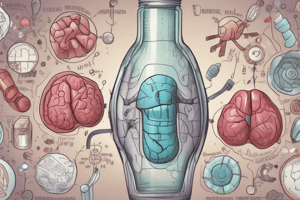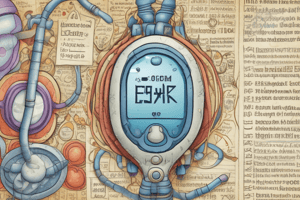Podcast
Questions and Answers
Which characteristic distinguishes insulin from other proteins?
Which characteristic distinguishes insulin from other proteins?
- It contains only 30 amino acids.
- It is arranged in two chains linked by disulfide bridges. (correct)
- It is not linked by disulfide bridges.
- It is arranged in a single chain.
What stimulates an additional release of insulin beyond the steady basal rate?
What stimulates an additional release of insulin beyond the steady basal rate?
- Decrease in blood glucose.
- Increase in blood glucose. (correct)
- Increase in circulating glucagon.
- Decrease in glucagon secretion.
After insulin binds to its receptor, what intracellular event primarily facilitates glucose uptake?
After insulin binds to its receptor, what intracellular event primarily facilitates glucose uptake?
- Activation of ATP-sensitive potassium channels.
- Depolarization of the cell membrane.
- Translocation of GLUT4 transporters to the cell membrane. (correct)
- Increased synthesis of glucokinase.
What is the primary action of insulin on liver glycogen?
What is the primary action of insulin on liver glycogen?
Which characteristic is associated with Type 1 Diabetes Mellitus (IDDM)?
Which characteristic is associated with Type 1 Diabetes Mellitus (IDDM)?
A patient with Type 1 diabetes requires insulin therapy. Which method of insulin delivery allows for the finest adjustments to basal and bolus rates?
A patient with Type 1 diabetes requires insulin therapy. Which method of insulin delivery allows for the finest adjustments to basal and bolus rates?
Which type of insulin is most suitable for managing postprandial glucose excursions due to its rapid onset and short duration of action?
Which type of insulin is most suitable for managing postprandial glucose excursions due to its rapid onset and short duration of action?
In which clinical scenario is intravenous (IV) administration of short-acting insulin most appropriate?
In which clinical scenario is intravenous (IV) administration of short-acting insulin most appropriate?
What is the advantage of using rapid-acting insulin analogs over regular insulin?
What is the advantage of using rapid-acting insulin analogs over regular insulin?
A patient with Type 1 diabetes expresses concern about erratic blood glucose levels. The physician recommends combining rapid-acting and long-acting insulin. What is the rationale?
A patient with Type 1 diabetes expresses concern about erratic blood glucose levels. The physician recommends combining rapid-acting and long-acting insulin. What is the rationale?
Which of the following is a common side effect associated with insulin therapy?
Which of the following is a common side effect associated with insulin therapy?
During the treatment of diabetic ketoacidosis (DKA), what initial laboratory finding would you expect?
During the treatment of diabetic ketoacidosis (DKA), what initial laboratory finding would you expect?
In the management of DKA, which approach takes priority?
In the management of DKA, which approach takes priority?
What is the most important factor in determining the appropriateness of oral antidiabetic agents in managing type 2 diabetes?
What is the most important factor in determining the appropriateness of oral antidiabetic agents in managing type 2 diabetes?
What distinguishes glucagon-like peptide-1 (GLP-1) analogs from other antidiabetic agents?
What distinguishes glucagon-like peptide-1 (GLP-1) analogs from other antidiabetic agents?
A patient with type 2 diabetes is prescribed semaglutide. By what primary mechanism does this agent lower blood glucose?
A patient with type 2 diabetes is prescribed semaglutide. By what primary mechanism does this agent lower blood glucose?
A patient on Pramlintide should be educated about the risk of which of the following side effects?
A patient on Pramlintide should be educated about the risk of which of the following side effects?
For a patient with newly diagnosed type 2 diabetes, what is generally the first-line treatment approach?
For a patient with newly diagnosed type 2 diabetes, what is generally the first-line treatment approach?
What is the primary mechanism of action of biguanides in treating type 2 diabetes?
What is the primary mechanism of action of biguanides in treating type 2 diabetes?
What is the primary reason that lactic acidosis is a concern when prescribing metformin?
What is the primary reason that lactic acidosis is a concern when prescribing metformin?
How do thiazolidinediones (glitazones) improve glycemic control in patients with type 2 diabetes?
How do thiazolidinediones (glitazones) improve glycemic control in patients with type 2 diabetes?
What is a significant adverse effect associated with the use of glitazones, particularly in susceptible individuals?
What is a significant adverse effect associated with the use of glitazones, particularly in susceptible individuals?
Which mechanism best describes how sulfonylureas lower blood glucose levels?
Which mechanism best describes how sulfonylureas lower blood glucose levels?
What is the primary requirement for sulfonylureas to be effective in managing type 2 diabetes?
What is the primary requirement for sulfonylureas to be effective in managing type 2 diabetes?
What clinical implication arises from the fact that sulfonylureas are metabolized by the liver and excreted in the urine?
What clinical implication arises from the fact that sulfonylureas are metabolized by the liver and excreted in the urine?
Which concurrent medication would most likely potentiate the hypoglycemic effects of sulfonylureas?
Which concurrent medication would most likely potentiate the hypoglycemic effects of sulfonylureas?
What is a common side effect of meglitinides (glinides)?
What is a common side effect of meglitinides (glinides)?
Which of the following is a key attribute of meglitinides (glinides)?
Which of the following is a key attribute of meglitinides (glinides)?
Which characteristic distinguishes alpha-glucosidase inhibitors from other oral antidiabetic drugs?
Which characteristic distinguishes alpha-glucosidase inhibitors from other oral antidiabetic drugs?
What should patients be instructed regarding when to take alpha-glucosidase inhibitors relative to meals?
What should patients be instructed regarding when to take alpha-glucosidase inhibitors relative to meals?
A patient taking acarbose complains of increased flatulence and abdominal discomfort. How is this likely related to the drug's mechanism of action?
A patient taking acarbose complains of increased flatulence and abdominal discomfort. How is this likely related to the drug's mechanism of action?
What is the main outcome that results from inhibiting DPP-4 enzyme activity?
What is the main outcome that results from inhibiting DPP-4 enzyme activity?
By which mechanism do sodium-glucose cotransporter-2 (SGLT2) inhibitors lower blood glucose levels?
By which mechanism do sodium-glucose cotransporter-2 (SGLT2) inhibitors lower blood glucose levels?
With use of SGLT2 inhibitors, you may see what serious side effect?
With use of SGLT2 inhibitors, you may see what serious side effect?
After lifestyle interventions and metformin therapy have failed to achieve target glycemic control in a patient with type 2 diabetes, what is the next step?
After lifestyle interventions and metformin therapy have failed to achieve target glycemic control in a patient with type 2 diabetes, what is the next step?
Flashcards
What is insulin?
What is insulin?
A small protein with 51 amino acids in two chains (A and B) linked by disulfide bridges.
Basal insulin release
Basal insulin release
Insulin is steadily released to regulate blood glucose, even during fasting. Glucose produced by the liver.
Insulin Action
Insulin Action
Insulin stimulates uptake of glucose, amino acids, and fatty acids. Increases glycogen formation and inhibits liver glycogen breakdown.
Diabetes Mellitus
Diabetes Mellitus
Signup and view all the flashcards
Type 1 Diabetes (IDDM)
Type 1 Diabetes (IDDM)
Signup and view all the flashcards
Type 2 Diabetes (NIDDM)
Type 2 Diabetes (NIDDM)
Signup and view all the flashcards
Drugs to control DM
Drugs to control DM
Signup and view all the flashcards
Rapid-acting insulin
Rapid-acting insulin
Signup and view all the flashcards
When to use short-acting insulin
When to use short-acting insulin
Signup and view all the flashcards
Intermediate-acting insulin
Intermediate-acting insulin
Signup and view all the flashcards
Long-acting insulins
Long-acting insulins
Signup and view all the flashcards
Premixed insulin combinations
Premixed insulin combinations
Signup and view all the flashcards
Clinical uses of insulin
Clinical uses of insulin
Signup and view all the flashcards
Insulin regimens
Insulin regimens
Signup and view all the flashcards
Insulin therapy side effects
Insulin therapy side effects
Signup and view all the flashcards
Diabetic ketoacidosis
Diabetic ketoacidosis
Signup and view all the flashcards
Diabetic ketoacidosis Treatment
Diabetic ketoacidosis Treatment
Signup and view all the flashcards
Metformin in Beta Cells
Metformin in Beta Cells
Signup and view all the flashcards
Biguanides
Biguanides
Signup and view all the flashcards
Metformin Side effects
Metformin Side effects
Signup and view all the flashcards
Metformin C/I
Metformin C/I
Signup and view all the flashcards
Metformin use
Metformin use
Signup and view all the flashcards
Thiazolidinediones
Thiazolidinediones
Signup and view all the flashcards
a glucosidase inhibitors site action
a glucosidase inhibitors site action
Signup and view all the flashcards
A/E a glucosidase inhibitors
A/E a glucosidase inhibitors
Signup and view all the flashcards
Side effects of
Side effects of
Signup and view all the flashcards
C/I a glucosidase inhibitors
C/I a glucosidase inhibitors
Signup and view all the flashcards
Dipeptidyl peptidase DPP4 Inhibitors
Dipeptidyl peptidase DPP4 Inhibitors
Signup and view all the flashcards
Incretin has 1 -2 mintutes
Incretin has 1 -2 mintutes
Signup and view all the flashcards
1 rapidly degraded
1 rapidly degraded
Signup and view all the flashcards
SE pain , headache
SE pain , headache
Signup and view all the flashcards
2 cotransporter2 inhibitors
2 cotransporter2 inhibitors
Signup and view all the flashcards
SE less Dehydration
SE less Dehydration
Signup and view all the flashcards
Study Notes
- Insulin is used to treat diabetes, and can have several side effects
- The Clinical Pharmacology and Therapeutics Module covers the pharmacology of insulin
- Key topics include the classification, mechanisms, pharmacokinetics/dynamics, side effects, insulin therapy selection, and diabetic ketoacidosis
Learning Objectives:
- Primary antidiabetic drug classes should be categorized
- Explain the mechanisms by which different antidiabetic drug classes lower blood glucose levels and their effects
- Discuss the pharmacokinetic and pharmacodynamic properties of key antidiabetic medications
- Common side effects, contraindications, and potential drug interactions should be listed for each class of antidiabetic drugs
- Select the appropriate insulin therapy based on onset, peak, and action duration
- Provide a definition of diabetic ketoacidosis along with treatment goals
Insulin Overview:
- Insulin is a small protein containing 51 amino acids
- Two chains (A and B) are linked by disulfide bonds
- Pancreatic B cells in the islets of Langerhans secrete insulin
Normal Insulin Secretion:
- Insulin is released at a steady rate, with additional releases in response to increased blood glucose
- Insulin is secreted in a steady rate during fasting to regulate glucose
- Increased blood glucose stimulates an additional insulin response
- The duration of action of endogenous insulin is 4-5 minutes
Insulin Action:
- Insulin stimulates cells to take up glucose from the blood (muscle and adipose tissue)
- It also increases the storage of glucose, amino acids, and fatty acids
- Insulin increases glycogen formation and storage in the liver
- Insulin inhibits liver glycogen breakdown
Diabetes Mellitus:
- Diabetes mellitus is characterized by elevated blood glucose
- High blood sugar is associated with absent or inadequate pancreatic insulin secretion, and/or impaired insulin action
Types of Diabetes:
- Type 1 Diabetes (IDDM): autoimmune destruction
- Type 2 Diabetes (NIDDM)
- Secondary: caused by drugs, pancreatectomy, or genetics
- Gestational diabetes
Treatment of Diabetes Mellitus:
- Drugs used to control diabetes mellitus fall into two groups
- Insulin: key for type 1 diabetes
- Antidiabetic agents: synthetic preparations that stimulate insulin release, sensitivity, or alter metabolic response to hyperglycemia
- Type II diabetics use a staged approach
- Stage 1 - diet control and weight management
- Stage 2 - oral antidiabetic medications
- Stage 3 - addition of insulin if oral agent therapy fails
Insulin Delivery Systems:
- Insulin Syringes: 100 unit (1.0ml)
- Insulin Pens
- Insulin Pumps
- Insulin Inhalers
Types of Insulin Preparations:
- Rapid-Acting: very fast onset and short duration
- Short-Acting: rapid onset of action
- Intermediate-Acting
- Long-Acting: slow onset of action
- Recombinant DNA technology produces insulin
- Insulin can be chemically identical to human insulin or a modification of human insulin to improve pharmacokinetics
Rapid-Acting Insulin:
- Lispro, Aspart, Glulisine and inhaled insulin are versions
- Closely mimics normal endogenous prandial insulin secretion
- Allows the body to undergo more normal insulin replacement
- It can be taken immediately before a meal without sacrificing glucose control
- Action duration is rarely >4-5 hours, which decreases the risk of late postmeal hypoglycemia
Short-Acting Insulin:
- Regular insulin is a form
- Particularly useful for IV therapy in the management of diabetic ketoacidosis
- It is used when insulin requirements are changing rapidly, like after surgery or during acute infections
Intermediate-Acting and Long-Acting Insulins:
- NPH (neutral protamine hagedorn, or isophane) insulin, is an intermediate-acting
- Insulin Glargine and Insulin Detemir are examples of long-acting insulin
Premixed Insulin Combinations:
- NPH mixed with both rapid and short-acting insulin analogs:
- 70:30 (70% NPH, 30% Regular)
- 50:50 (50% NPH and 50% insulin Lyspro)
- 70:30 mixtures (70% NPH, 30% insulin aspart)
Clinical Uses of Insulin:
- Patients with type 1 diabetes mellitus require long-term insulin
- An intermediate-acting preparation or a long-acting analog is often combined with soluble or rapid-acting forms
- Used IV in emergency treatment of hyperglycemic emergencies
- About 1/3 of patients with type 2 diabetes mellitus ultimately benefit
- Prescribred Short-term for patients with type 2 diabetes mellitus with impaired glucose tolerance during events like operations, infections, and myocardial infarction
- Used for gestational diabetes not controlled by diet alone
Insulin Regimens:
- Basal Only Regimens
- Basal-Bolus Regimen: An intermediate or long-lasting version is used to provide a basal level
- It extends overnight and is supplemented with fast or short-acting forms injected with meals
- Premixed to be given twice a day, with morning and evening meals:
- No mixing, a single injection, administered once or twice daily
- The typical does is between 0.5-0.8 IU/Kg/day
Insulin Therapy Side Effects:
- Hypoglycemia: Early symptoms include weakness, hunger, pallor, sweating, palpitation, irritability, tremor and headache
- If not treated it may lead to convulsion and coma
- Lipodystrophy at injection sites
- Weight gain
- Allergic reaction
- Generalized Urticaria
Studying That Suits You
Use AI to generate personalized quizzes and flashcards to suit your learning preferences.




